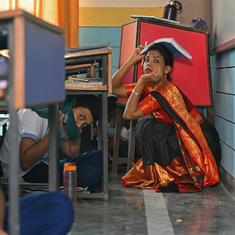By night, she roams Mumbai’s Kamathipura in search of sexual predators, whose genitals she can turn into stone with a single shriek. By day, she is an affable bai, who cleans homes and washes laundry. She is Bai-sexual.
The superheroine, created by artist Rucha Dhayarakar, was an entry in Sthree Sthree September, an online event organised by the artists’ collective Brainded India. Dhayarakar’s submission came with a complete backstory: “Growing up in a brothel in Kamathipura…. She was expected to follow the path of her mother and become a lady of the night, and a lady of the night she did become, just not in the conventional way.”
Brainded India posted Bai-sexual on its Facebook and Instagram pages, along with about 25 other creations sent in by Indian artists. These submissions were in response to Brainded India’s open call in August inviting artists to illustrate an Indian superheroine and detail her powers, costume, name and insignia.
Sthree Sthree September “was the culmination of many parallel conversations,” said Catherine Rhea Roy, editor-curator at Brainded India. “The impossible expectations on women, the heinous crimes and incidents of violence against women and girls, and we thought what better way to capture this absurd dichotomy in art than with superheroines.”
Almost all the entries had elements of fun and humour, said Roy. “The superheroines have been regular women, like domestic help, mothers, bakers, girls who like to party, schoolgirls, all with a single thought in their head – how to prevent sexual assault and violence against women? What we saw in the entries were agents who could curb the daily menace – cat-calling, leering, gawking – the everyday irritants we come in contact with in public spaces, public transport, or while simply walking down the street.” Each entry went through an approval process to ensure the correct message was sent out.
Kruttika Susarla’s superheroine Moh-Maya can “dismantle the patriarchy, violence against women and girls and end mansplaining”. Ankhmari Jaan, created by Arundhati Ghosh and George Mathen, can get men pregnant by simply winking at them.
“We [at Brainded] are not the biggest fans of mainstream superheroes,” said Mathen, a founder of Brainded and a graphic novelist who uses the pen name Appupen. “With Sthree Sthree September, we hope to blow up the image of the superheroine and give her an indie or even and Indian identity. We have lots of exciting new creators who don’t see comics as ‘superhero’ stuff. They tell their own tales in their own styles.”
For some artists, it was not a larger-than-life ability that made their character superhuman – often, it was something as simple as determination. Vishnu M Nair’s superheroine, for instance, is a mother who perseveres in the face of hopelessness, as she attempts to give her children a better life than the one she had. In his comic, Poonam 3000, the superheroine mother works with unrelenting resolve to earn enough to admit her son into a private school.
“When given the brief for a superheroine, my first thought was that it is challenging enough being a woman on a day-to-day basis,” said Nair. “How much difference could fighting off a few supervillains make? What I wanted to show was that this exaggerated, monumental narrative of the giant mechanised heroine, was, at the end of the day, only one of the many smaller tasks a working mother had to complete as part of her day job, to fulfill more humble goals. Also, I wanted to show that whether you are a working mother or a heroine, no one struggle is greater than the other.”
For Lavanya Karthik, inspiration came from grandmothers. Karthik’s Ninja Nani, Argumentative Ammamma, Detached Dida and Peacemaker Paati, are a tribute to these endearing women who run the household with finesse and are never short of providing love and encouragement. Annanda Menon’s superheroine is loosely based on her mother: Miss Pummela is a baker by day and fights goons no matter what time of the day it is.
The panels of the comic created by Menon show Miss Pummela perform superhuman feats as she contorts her body to fold, knead and stretch a goon as if he were a ball of dough. “She stretches their body like a taffy puller,” writes Menon. “Looks painful, doesn’t it? Blood, bones, organs, muscles, every element inside the body turns into a mouldable mass by her touch.”
Manjula Padmanabhan’s Lady Knight, wearing chainmail and shin guards, is a scholar and a warrior. Her superpower: compassion. Padmanabhan is the creator of the Indian comic character Suki, which has been published in newspapers such as Sunday Observer, Pioneer and Hindu Business Line. “It was a lot of fun deciding what elements to add to Lady Knight’s ‘baggage’,” said Padmanabhan, referring to how her character carries supplies to support herself, including a bedding roll, manual typewriter, kettle, paintings and running shoes, among other things. “The point of the character is to send out a message of independence, strength of purpose and a sense of humour, all the things that I believe are essential to life.”
The response on social media, said Roy, was encouraging, considering how these comics are outside the more popular Marvel and DC universes. “With Sthree Sthree September we were only able to ask the artists to give us a character, but we have since received requests, from those who have been reading and following the artists’ works, for prints, compilations and detailed adventures of the female supers from audiences.”










